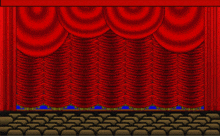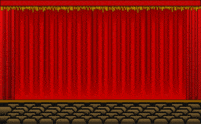Professor Davidson’s mention of the 1984 Super Bowl Macintosh commercial in her blog post made me think about the ways that design and architecture impact the way that we consume media. I initially thought about the design of theaters as external to the medium of film itself, but the extent to which movie theaters still feature curtains around the screen made me wonder about why this was such an important part of cinema design. Beyond dampening sound, this seems like a purely decorative holdover; the actual opening of a curtain has been a part of my movie-going experience only a handful of times (and these were all years ago). Additionally, most of the theaters where I grew up were built during or after the 1990s and simply have a horizontal drape running along the top of the screen and two panels hanging down the sides to imitate curtains open on a stage with a proscenium arch. Movie theaters seem to be remediating an aspect of theater design that is no longer a necessary component the medium they’re meant to showcase, but why? I realize that the connections between theater and stage design and media might be tenuous ones, but I’m hoping that my sketch of similarities and differences between these two different types of theaters can say something productive.
My assumption is that theater curtains help to create the sense of immediacy, the sense that we are looking into a “real” world when watching a play. Depending on the production, the proscenium arch and curtains often end up demarcating where the play’s action takes place on the stage, which (I argue) means that it becomes a part of the medium whether we think about it that way or not. It offers hypermediacy in the way that it reminds us that what we’re watching should be immediate. It’s a “window” into something real, but we’re very aware of the artifice of that boundary. While an individual audience member may not experience the play like virtual reality, that is from a first-person point of view in which their standpoint is the “visual center of that world” (Bolter and Grusin 316), the production usually does direct their “play” towards them. Phrases like “pulling back” or “opening” the curtain signal that we are witnessing something real, often because we imagine it would be hidden if the theatrical experience hadn’t given us access at that immediate moment. This makes me think, also, of performances/rites in religious settings. I’ll use the example from my own upbringing in Christian churches whose services include the use (performance) of a fairly involved liturgy or order of service. The celebrant is often separated from the congregation by some form of horizontal boundary, usually a rail or steps—during the medieval period this would have often been a literal screen. What the congregation sees of these rites and what is prepared away from them (and out of sight) is carefully managed. I don’t think that proscenia have roots in Christian religious celebrations, so this is more of an affinity than a strict genealogy; however, I think the comparison is a striking one since both of these practices of separation highlight an assembled group of people’s immediate perception of a type of reality. In the case of believers, this usually involves the corporeal manifestation of a deity. For an audience in a proscenium theater, the curtain rising often marks the spatial and temporal limits of the world of a play, a world which they choose to believe in. While audiences may want to believe in the immediacy of that staged world, it is (depending on the production) immediacy is often dependent on the hypermediacy of the window created by proscenium and curtains.
My initial assumption was that movie theaters (movie “palaces” in their heyday) simply appropriated curtains because films were shown in theaters meant for stage productions, or because theater operators wanted to mimic the familiar experience of going to staged plays. After some brief (and rather inconclusive) research, I’ve learned that the use of the front curtain in movie theaters often had a bit more of an active role in an audience member’s movie-going experience than I’d assumed. In the same way that the closing of curtains often signaled the break between acts or scenes for a staged show (allowing time for scenery to shift, etc.), curtains would often be opened and closed between newsreels, shorts, and main features. One commenter, responding to a piece in the Chicago Reader on the decreased use of curtains in movie theaters argues for their benefit by noting that:
Projectionists in the old days were trained never to let the audience see the white screen. You dimmed the lights, started the projector, opened the dowser and then opened the curtains on the first images to hit them. Some theatre owners and projectionists preferred opening after the studio logo faded out. Same thing when the movie ended, curtain closing timed to end with final fade out, again no white screen visible to your audience!
This irritation at seeing a blank screen hints at a sort of horror vacui. If the architecture of movie theaters originally remediated that of a live theater through the use of a proscenium arch and curtains, this abhorrence of the blank space of the screen makes sense. Many audience members at these types of live theaters would rarely, if ever, have seen the cavernous empty backstage space behind scrims and set pieces. Similarly, Ben Sachs, the author of the same Chicago Reader piece laments that “cinemas would forgo this age-old amenity, which has the effect of rendering the big screen separate from (one might even say more mysterious than) the world outside the theater” (Sachs). Sachs’s desire for a separation between the world of the screen and the outside speaks to a wish to lose oneself in the former. While film’s remediation of certain elements of the stage may promise a more immediate experience, it is the hypermediated action of drawing back the curtain that (for him) facilitates that immediacy. We want to believe that we are looking through a window into a different world. As Sachs asks, “How can a theater create anticipation for a movie when it seems as though the projectionist has arrived at it by changing the channel on a giant TV?” (Sachs). This comment makes it clear that curtains are an unnecessary aspect of watching a film. However, the framing function that they perform, while a construct, appears to make the experience of film more real.
I realize that we consume film very differently these days, so this example may not make as much sense as I’m hoping. Similarly, a proscenium is only one type of stage, and immersive theater productions like Sleep No More certainly don’t fit in with this analysis (though I wonder if we could think productively about the ways that they remediate virtual reality experiences). Indeed, I’m still concerned that theater doesn’t really work as an example at all. At the very least, however, thinking about the ways that theater curtains create a “window” onto an scene that is meant to feel immediate has given me a helpful way to think about that experience along with hypermediacy.
Thanks for reading!


I didn’t do this module this week, so my comments likely don’t connect very much to the readings, but I foresee your curtains analogy/analysis being really helpful as I attempt to concretize those readings in whatever week I’m doing them! Your discussion made me think of Alfred Hitchcock–he put so many “rules” in place for how theaters should show Psycho when it hit theaters. First horror movie ever–ticket lines went for blocks! He had recordings of his voice played throughout theater lobbies “___ minutes to Psycho” so audiences knew to get inside before the start of the show: no one could enter leave or leave the theater once it started (I wonder about that–it would never work nowadays; did people really not leave even if they had to go to the bathroom?) The role of the curtain, as you present it here, fits right in with his plans.
Very few elements have been remediated more than the simple window! I guess you could say the window and the screen are related elements, but mythology, literature, religion, philosophy, etc. plays around with the differences between them in interesting ways. One of the earliest famous known tales of the screen would have to be Plato’s cave in The Republic where people view projected moving images/shadows and think they are real. Think of John Donne’s glass darkly, through which he can dimly view the face of Christ, but hopes to eventually view face-to-face after judgment. I would bring up windows because the stage, and later the movie screen, were meant at one time to be a window onto the created world of theater (and later the movie). When Remediation was penned in the later 90s, much was made by thinkers like Grusin and Bolter about the computer “screen” and its software’s “windows.” I think it’s fair to say humanities people really took to Macintosh software because of the emphasis on windows (not Windows, which came quite a bit later) and you start to see educators programming with Hypercard, which was a native Mac program that didn’t required too much backend coding knowledge. Hypercard emulates index cards, but also appears as little window panes which can be shared with others–they can see through to understand your meaning.
The framing provided in recent years by movie house screens and ornamentation seem like hypermediation, although as you point out, they were apparently originally meant to make sure that the audience was completely immersed in the film to the point of not being allowed to see the blank screen. Nostalgia, of course, is also involved (as there might be nostalgia in eating tubs of buttered popcorn in a movie showing–although undoubtedly there was a good reason once for the combination). If you want to think about framing more abstractly, consider Erving Goffman’s Frame Analysis:An Essay on the Organization of Experience (1974), which “Discusses the rationale of frame analysis, a method of studying how situations are defined and how various alternatives to ordinary activities (e.g., dreams, tests, fictional dramas, and playfulness) are developed. This type of analysis is also applied to everyday language, and its implications for a systematic sociological study of subjective experiences are examined” (abstract, https://psycnet.apa.org/record/1975-09476-000).